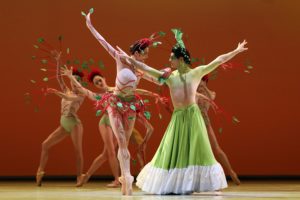Dutch National Ballet: Annabelle Lopez Ochoa / Frida - Vancouver Ballet Society
- Home
- Reviews 2020 - 2023
- Dutch National Ballet: Annabelle Lopez Ochoa / Frida

Frida Kahlo’s paintings are a blaze of colour, embedded in indigenous Mexican culture, and depicting a world quite apart from her life of chronic physical pain. In Kahlo’s iconic self-portraits, she eyeballs her audience with total honesty, exposing her broken and mangled body, the result of a crippling accident, and effectively subverting the male gaze. Hers was a short and dramatic life that ended in suicide at the age of 47.

Colombian-Belgian choreographer Annabelle Lopez Ochoa first tackled Kahlo’s life in a one-act ballet for English National Ballet in 2016. Broken Wings was a great success, but Ochoa felt the work needed to be longer to contain the artist’s tempestuous life. Even before the London premiere, she had said to Ted Brandsen, director of Dutch National Ballet, that her dream was for a full-evening Frida. “Well, let’s do your dream,” he replied. Four years later, Frida premiered in Amsterdam, on February 6, giving Ochoa the opportunity to flesh out the details of Kahlo’s relationship with husband Diego Rivera, one of Mexico’s greatest painters, and broaden the context.
The narrative is introduced in storybook sequence contained in the stage set of black boxes. It opens on the Day of the Dead, with the ubiquitous skeletons on hand to deliver the schoolgirl Frida, a bubbly child in gym-slip, from the first box. They swing open the doors of the following box to show her happy family, then the action fast forwards to Frida in bed, after the accident, nailed together with surgical pins, her father putting a paintbrush in her hand.
To suggest the scale of Kahlo’s paintings, small in reality, but today commanding international attention and prices, Ochoa has the dancers enact them; at other times, the dancers portray Kahlo’s fantasy world of trees, birds and flowers, which she painted as a way of coping in times of stress. The skeletons are always on hand to shift scenery, to lift and carry and even to indulge in a bit of clowning in what, at times, becomes a circus atmosphere.

The title role is one to covet, stretching physical and dramatic skills to the limit. Maia Makhateli captures the spirit of this feisty woman in a formidable performance. Kahlo’s troubled relationship with Rivera drags her through a gamut of emotions: love, jealousy, anger and despair, leading her to retreat into her art, with the ballet dissolving into a magic realist world of nature. A bird (Riho Sakamoto) symbolizes hope; a solitary deer, loneliness. Kahlo had painted the deer pierced with arrows and bearing her face; from this creature, danced by Erica Horwood, Ochoa created a graceful and delicate alter-ego.
Knowing that Irek Mukhamedov, who created the role of Rivera for Ochoa’s ballet in London, would be a hard act to follow, she took a different approach to the character here. Using younger principal dancers, she added physical virtuosity while working to bring weight to the movements and an element of clumsiness into Rivera’s dishevelled character. These conflicting elements proved a challenge for Canadian James Stout, one of the company’s finest dancer/actors. While his dance was superb, he did not always convince in finding the essence of Rivera.
Ochoa’s concept of using 10 male Fridas for a corps de ballet, instead of the traditional bevy of ballet girlfriends, is a brilliant idea. The score of men in colourful costumes, skirts swirling like those of skilled matadors, have some of the best choreography. Virtuosic and powerful, they make their presence felt throughout.
Kahlo’s unfulfilled longing for a child is told in a potent scene where a child figure in pink dress and skeleton head is manipulated like a puppet. Her subsequent miscarriage, which ends onstage in a forest of bloodied umbilical cords, closes the first act.
The second act opens with a flashback. The music is a lilting folk song, one of many that composer Peter Salem has effectively woven into his score. The skeletons dance with the child Frida (Rosalie van den Bosch), a charmer who flirts shamelessly with them. The child Diego (Jitse Meijer) arrives and the skeletons try unsuccessfully to warn Frida off, but her fate is sealed. (Kahlo once wrote that meeting Rivera was her second and her worst accident.)
Fast forward to the married couple in the United States. Rivera, the international celebrity, dances to the tune of the paparazzi while Kahlo remains unacknowledged in his shadow, seeking solace in drink and a string of lovers. The clever set (by Dieuweke van Reij, who also designed the costumes) rotates between the urban monochrome and the technicolour brilliance of Rivera’s murals.
The second act ricochets between extreme emotions. The party where Kahlo discovers her husband’s affair with her sister plunges her into despair. The ballet shows glimpses of her fantasy garden, contrasting them with the cruel reality of Kahlo’s painting, The Broken Column, which is embodied by dancer Floor Eimers in anguished movement, in a costume that displays the metal bar replacing her spine.
The complex story is deftly handled, there is plenty of inventive choreography and a slew of excellent performances. The costumes are no small part of the success and Ochoa weaves these strands together in a ballet that has both entertainment value and depth.
— MAGGIE FOYER

